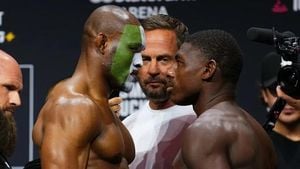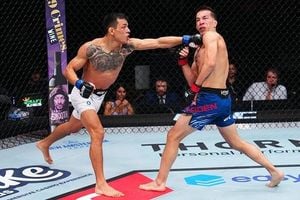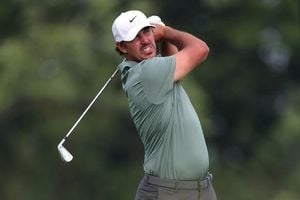Tyrese Haliburton is rapidly becoming the cornerstone of the Indiana Pacers’ playoff ambitions, showcasing a blend of skill, vision, and leadership that has fans buzzing and critics reconsidering. Despite some skepticism from prominent voices like ESPN’s Stephen A. Smith, who pointed to Haliburton’s inconsistent scoring during the regular season, the Pacers’ star guard is proving that his impact goes far beyond just putting points on the board.
Haliburton’s rise is especially evident in the 2025 NBA Finals, where his performance against the Oklahoma City Thunder has been pivotal. The Pacers secured a crucial 116-107 victory in Game 3 on their home court, taking a 2-1 series lead, thanks in large part to Haliburton’s aggressive yet calculated play. Coach Rick Carlisle praised his approach, stating, “I thought his approach tonight was exactly what it needed to be. A combination of spatial awareness and aggression, and you know, a real good feel for aggression to score along with getting his teammates involved at the right times.”
The narrative before Game 3 centered on Haliburton needing to be more aggressive to overcome the Thunder’s stifling defense. But as any NBA Finals game reveals, it’s never just about mindset—it’s about strategy, timing, and execution. Haliburton and Carlisle crafted a game plan that emphasized constant movement and unpredictability, essential to breaking down a defense as disciplined as Oklahoma City’s.
Haliburton himself acknowledged the challenge, noting, “If you try to hold the ball and call for screens, they crawl into you and pack the paint. It’s not easy. It’s really tough. That’s why they are such a historical defense. They do such a great job of that. You just have to continue to give them different looks as much as you can.” In Game 2, the Pacers had struggled with half-court execution, playing at the Thunder’s pace, which allowed Oklahoma City’s defenders to get over screens and stifle Indiana’s offense.
Game 3’s adjustments were critical. Rather than waiting for screens, Haliburton began attacking unpredictably, catching defenders off guard. Carlisle’s tactical move to deploy a small lineup with Pascal Siakam at center exploited Isaiah Hartenstein’s drop coverage on pick-and-rolls—a known weak spot in the Thunder’s defense. This switch opened up the floor, allowing Haliburton to drive into floater range and make plays that were previously difficult against the Thunder’s coverage.
One key sequence late in the second quarter highlighted this strategy: Haliburton and Siakam executed an inverted pick-and-roll where Siakam drove into the paint and kicked the ball out to Haliburton. Although Siakam didn’t score, the play’s objective was to draw defenders and create space for Haliburton. On the very next possession, a high pick-and-roll with Hartenstein dropping back led to a clean look for a three-pointer when Cason Wallace 'nexted' onto Haliburton, only for Haliburton to fake a pass and shoot, exploiting the defensive rotation.
Haliburton’s ability to keep his "tire temperature up," as Carlisle described, was evident throughout the game. By staying constantly on the move, Haliburton avoided the Thunder’s attempts to slow him down with staggered screens and aggressive ball swipes. Instead, he rejected some screens altogether, creating driving lanes or clearer passing options. Early in the game, he even skipped over a Myles Turner pick-and-roll to find Obi Toppin in the corner, leading to a drive to the rim—a testament to his court vision and adaptability.
With the game tightening in the fourth quarter, Haliburton showcased his playmaking prowess again. Up by five with three minutes remaining, he surged off a double screen and delivered a pinpoint cross-court pass to Aaron Nesmith, who drained a three-pointer despite tight coverage from Shai Gilgeous-Alexander. This play epitomized the Pacers’ strategy of maintaining pace and playing "random basketball," as Haliburton put it, to keep the Thunder’s defense off balance.
Haliburton’s aggression also wore down Hartenstein, who briefly re-entered the game in the fourth quarter only to be immediately targeted. After Haliburton tipped a defensive rebound to Myles Turner, he quickly pointed to Andrew Nembhard to set up a pitch action that left Hartenstein scrambling and ultimately led to Haliburton hitting a three-pointer. This sequence forced Hartenstein back to the bench, highlighting Haliburton’s impact on the game’s flow and personnel decisions.
Despite his on-court success, Haliburton hasn’t escaped criticism. Stephen A. Smith publicly questioned Haliburton’s superstar potential, focusing on his inconsistent scoring. After the Pacers’ Game 3 win, Haliburton took a subtle jab at the media, saying, “The commentary is always going to be what it is. Most of the time, the talking heads on the major platforms, I couldn’t care less, honestly. Like, what do they really know about basketball?” Smith responded on ESPN’s "First Take," stating, “If he was talking about me…players far more accomplished and more superior have made their efforts trying to call me out. How has that worked out? I’ll be here no matter what, remember that wins a chip.” This exchange sparked further attention when former MLB star and host Cody Decker criticized Smith, sharing a clip and calling him a “little b—ch,” fueled partly by past grievances involving SiriusXM job shifts.
These off-court dramas add spice to an already intense playoff atmosphere, but the focus remains on Haliburton’s evolving game. His ability to combine scoring, playmaking, and leadership under pressure is what truly defines his value to the Pacers. His resilience and adaptability, especially in the high-stakes environment of the NBA Finals, reflect a player growing into his role as a franchise leader.
Looking ahead, Haliburton himself recognizes the ongoing chess match with the Thunder. “We have adjustments to make. They have adjustments to make,” he said. “You’ve got to consistently play (with) pace, random basketball and good things will happen.” The Pacers’ future in this series—and perhaps beyond—hinges on Haliburton’s continued ability to innovate, lead, and inspire on the hardwood.
As the series progresses, the spotlight will remain firmly on Haliburton, whose journey from a promising young guard to a potential NBA star is unfolding in real time. Whether he can silence his critics and elevate the Pacers to new heights remains to be seen, but one thing is clear: his impact on the game is undeniable, and his story is far from over.




